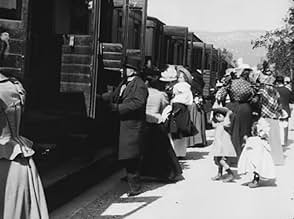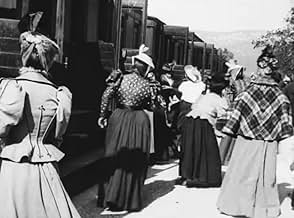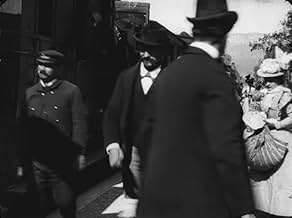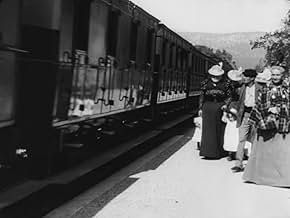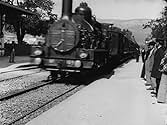NOTE IMDb
7,4/10
14 k
MA NOTE
Ajouter une intrigue dans votre langueA train arrives at La Ciotat station.A train arrives at La Ciotat station.A train arrives at La Ciotat station.
- Réalisation
- Casting principal
Avis à la une
A train arrives at a station. And changes everything.
There isn't a lot to really say about L'arrivée d'un train a La Ciotat as a film itself. It's under a minute and shows a train pull up at a busy station. But what it signifies is another thing altogether. When we see that train come closer and closer until it stops in the station, on a surface level we watch a train arrive but it actuality what we are really witnessing is cinema arrive. This short film may not be the earliest movie but it is the first iconic image of the moving picture age.
Auguste and Louis Lumière weren't really artists. Their early films don't stand up to the highly imaginative work of George Méliès for example. But they still remain enormously important cinema giants. Not for the content of their films but for the fact that they kicked things off in the first place and produced the first iconic moment in cinema history. And for this reason L'arrivée d'un train a La Ciotat will always be remembered. Everyone who has a love of cinema should really take a minute of their time to pay homage to the first moment in an amazing journey.
There isn't a lot to really say about L'arrivée d'un train a La Ciotat as a film itself. It's under a minute and shows a train pull up at a busy station. But what it signifies is another thing altogether. When we see that train come closer and closer until it stops in the station, on a surface level we watch a train arrive but it actuality what we are really witnessing is cinema arrive. This short film may not be the earliest movie but it is the first iconic image of the moving picture age.
Auguste and Louis Lumière weren't really artists. Their early films don't stand up to the highly imaginative work of George Méliès for example. But they still remain enormously important cinema giants. Not for the content of their films but for the fact that they kicked things off in the first place and produced the first iconic moment in cinema history. And for this reason L'arrivée d'un train a La Ciotat will always be remembered. Everyone who has a love of cinema should really take a minute of their time to pay homage to the first moment in an amazing journey.
This footage of the "Arrival of a Train" is one of the most enduring images of the earliest years of cinema. The often-repeated accounts of the startled reactions to this movie from early audiences, along with the ways that such reactions were commemorated in other early movies such as "The Countryman and the Cinematograph", have made it one of the best-known of the earliest movies, and beyond that, the film in itself accomplishes its own aim very well.
The Lumières discovered very quickly how effective motion towards the camera could be, and that idea is certainly used to good effect here. The diagonal direction of the motion, necessitated by the material being filmed, gives it a distinctive character. Compared with the train, the crowd reactions here are a bit less interesting than they are in some of the other Lumière features that include crowds who know they are being filmed. A couple of them do acknowledge the camera as they go about their business.
Yet even today, the train grabs the viewer's notice, so that the crowd and other details get much less attention. That in itself shows how effectively this enduring classic was able to carry out an interesting idea.
The Lumières discovered very quickly how effective motion towards the camera could be, and that idea is certainly used to good effect here. The diagonal direction of the motion, necessitated by the material being filmed, gives it a distinctive character. Compared with the train, the crowd reactions here are a bit less interesting than they are in some of the other Lumière features that include crowds who know they are being filmed. A couple of them do acknowledge the camera as they go about their business.
Yet even today, the train grabs the viewer's notice, so that the crowd and other details get much less attention. That in itself shows how effectively this enduring classic was able to carry out an interesting idea.
I have little to add to other reviewers, except to say that this film took a sudden importance in my life last year. In 2002 I was travelling by train to my first ever Cannes Film Festival. At one point the train was moving slowly and I looked out of the window and found that we were pulling through La Ciotat, and the platform hadn't changed a bit. Sadly the train didn't stop, otherwise I would have been tempted to jump off for a moment, but given the purpose of my journey I felt a strange thrill at being there. Just a little personal anecdote, but perhaps it shows something of the power and importance of those early steps in film.
I watched this film on a DVD that was rammed with short films from the period. I didn't watch all of them as the main problem with these type of things that their value is more in their historical novelty value rather than entertainment. So to watch them you do need to be put in the correct context so that you can keep this in mind and not watch it with modern eyes. With the Primitives & Pioneers DVD collection though you get nothing to help you out, literally the films are played one after the other (the main menu option is "play all") for several hours. With this it is hard to understand their relevance and as an educational tool it falls down as it leaves the viewer to fend for themselves, which I'm sure is fine for some viewers but certainly not the majority. What it means is that the DVD saves you searching the web for the films individually by putting them all in one place but that's about it.
Anyway onto this film which is the continuation of the understandable Lumière standard of standing a camera pointing at an event and then recording it happen. In this case a train pulls into a station and people get out. In terms of action it is not that interesting but in regards history of cinema it does offer something at least. It struck me that the other films from Lumiere I had seen to this point had point head on at the action whereas this one was set so that we had a wider view and that things played out across the screen towards the viewer. Also amusing is that some people become awkward when they notice the camera whereas other just bluster in front of it unaware.
The usual fare then that produces little of interest in terms of actual content but has more of interest when viewed in its historical and cultural context.
Anyway onto this film which is the continuation of the understandable Lumière standard of standing a camera pointing at an event and then recording it happen. In this case a train pulls into a station and people get out. In terms of action it is not that interesting but in regards history of cinema it does offer something at least. It struck me that the other films from Lumiere I had seen to this point had point head on at the action whereas this one was set so that we had a wider view and that things played out across the screen towards the viewer. Also amusing is that some people become awkward when they notice the camera whereas other just bluster in front of it unaware.
The usual fare then that produces little of interest in terms of actual content but has more of interest when viewed in its historical and cultural context.
There doesn't seem to be anything particularly exciting about an approaching steam locomotive, but somehow this image has stuck, the first iconic scene in cinematic history. Produced by pioneering French filmmakers Auguste and Louis Lumière, 'L' Arrivée d'un train à La Ciotat / Arrival of a Train at La Ciotat' was filmed at La Ciotat, Bouches-du-Rhône, France on December 28, 1895 and first screened to a paying audience on January 6, 1896. The 50-second long film, like most other Lumière shorts, successfully captures a brief snippet of everyday life, chronicling the gradual approach of the train, its slow to a halt, and the disembarkment of its passengers.
For many years, there has been an enduring myth than, upon the first screening of the film, the audience was so overwhelmed by the image of the train bearing down upon them that they fled the room in terror. This has been shown to be something of an embellishment, and, though the film would undoubtedly have astounded and mesmerised audiences, there was never any real mass panic. French scientist Henri de Parville, who attended an early screening, is said to have written: "The animated photographs are small marvels. ...All is incredibly real. What a power of illusion! ...The streetcars, the carriages are moving towards the audience. A carriage was galloping in our direction. One of my neighbors was so much captivated that she sprung to her feet... and waited until the car disappeared before she sat down again." This, I think, adequately sums up how remarkable the film must have seemed back in 1896.
Auguste and Louis Lumière obviously recognised the power of illusion offered by their Cinématographe. In order to maximise the shock value of the approaching train, they have mounted the camera as close as possible to the edge of the platform, so that the audience feels as if they are almost standing right in the locomotive's path. The people departing from the train are just normal citizens going about their day (several Lumière relatives, however, can be spied on the platform), enhancing the realism of the short. Cinema does not get much more memorable than this.
For many years, there has been an enduring myth than, upon the first screening of the film, the audience was so overwhelmed by the image of the train bearing down upon them that they fled the room in terror. This has been shown to be something of an embellishment, and, though the film would undoubtedly have astounded and mesmerised audiences, there was never any real mass panic. French scientist Henri de Parville, who attended an early screening, is said to have written: "The animated photographs are small marvels. ...All is incredibly real. What a power of illusion! ...The streetcars, the carriages are moving towards the audience. A carriage was galloping in our direction. One of my neighbors was so much captivated that she sprung to her feet... and waited until the car disappeared before she sat down again." This, I think, adequately sums up how remarkable the film must have seemed back in 1896.
Auguste and Louis Lumière obviously recognised the power of illusion offered by their Cinématographe. In order to maximise the shock value of the approaching train, they have mounted the camera as close as possible to the edge of the platform, so that the audience feels as if they are almost standing right in the locomotive's path. The people departing from the train are just normal citizens going about their day (several Lumière relatives, however, can be spied on the platform), enhancing the realism of the short. Cinema does not get much more memorable than this.
Le saviez-vous
- AnecdotesPopular legend has it that, when this film was shown, the audience fled in terror, fearing being run over by the "approaching" train. This legend has since been identified as promotional embellishment, though there is evidence to suggest that people were astounded at the capabilities of the Lumières' cinématographe.
- ConnexionsEdited into Louis Lumière (1968)
Meilleurs choix
Connectez-vous pour évaluer et suivre la liste de favoris afin de recevoir des recommandations personnalisées
Détails
- Date de sortie
- Pays d’origine
- Langue
- Aussi connu sous le nom de
- L'arrivée d'un train en gare de La Ciotat
- Lieux de tournage
- Société de production
- Voir plus de crédits d'entreprise sur IMDbPro
- Durée
- 1min
- Couleur
- Mixage
- Rapport de forme
- 1.31 : 1
Contribuer à cette page
Suggérer une modification ou ajouter du contenu manquant

